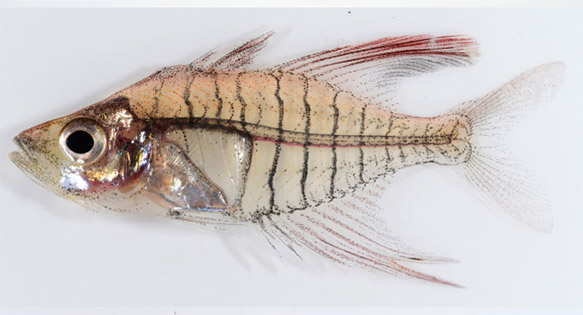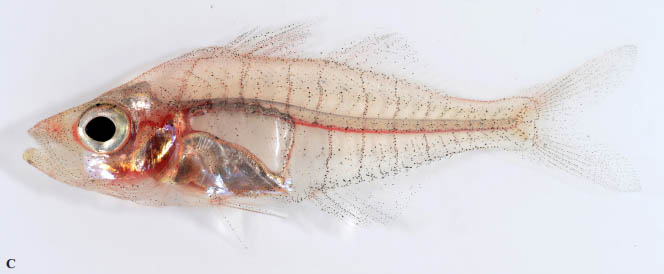A new species of Glassfish has been described in the September 22nd, 2014 paper “Gymnochanda ploegi, a new species of ambassid glassperch from West Kalimantan, Indonesia”, authored by Tan Heok Hui & Kelvin Lim Kok Peng.

The male holotype of Gymonochanda ploegi. The paper’s authors noted that the split anal fin on the holotype was mechanical damage.
We take a first note to mention the etymology of this species name, which was chosen “in memory of Alex Ploeg, a good friend, fellow taxonomist, advisor and fellow conservationist against alien aquatic species; for his services to the ornamental fish trade in this region and abroad in his role as the Secretary General of the Ornamental Fish International; who unfortunately perished in a terrible tragedy over Ukraine on 17 July 2014.” Truly a fitting tribute in remembrance of a man, and family, whom many are still mourning.
We are struck by the beauty of this species, which happens to offer surprising sexual dichromatism and dimorphism.
Per the paper’s abstract:
A spectacularly coloured sexually dimorphic freshwater glassfish allied to Gymnochanda verae is described herein. It shares with its other congeners a body without scales, but differing from its congeners with males having a maroon-red first dorsal fin, expanded maroon-red anal and second dorsal fins with black distal portions, without any individual fin ray elongations free from the interradial fin membranes; head with reddish opercle cover. A key to the genus Gymnochanda is also provided.
Members of the genus Gymnochanda have been reported as delicate aquarium fish and members of the genus are not often seen offered for sale. Interestingly, it is reported that the specimens used for this description were trapped for the aquarium trade and were part of a first collection of the species for export. The paper describes this fish as coming from still water pools near swamps and rivers, specifically trapped in “brown water”, which suggests that this species’ care requirements would be in line with other species that require softer, acidic water.
We encourage you to read the full species description of Gymochanda ploegi, and should you be lucky enough to keep this new species in an aquarium successfully, we’d love to hear how you did!
Source and Image Credits: http://lkcnhm.nus.edu.sg/nus/images/data/raffles_bulletin_of_zoology/zoology_volume_62/62rbz688-695.pdf
Special Thanks to the Freaky Fish Club for bringing this to our attention.
UPDATED: 9/25/2014 – we incorrectly labeled an image of Gymnochanda verae from this publication as a paratype of G. ploegi. We have removed this image to eliminate any confusion and to highlight only the newly-described G. ploegi.







The first composite diagram shows two different species, top being Gymnochanda verse male, below being Gymnochanda ploegi male.
Tan Heok Hui, thank you GREATLY for catching this very obvious mistake. It will be updated & corrected immediately.
Also may I extended our personal congratulations on the news species description!
The place for G.Ploegi that were stated above is not accurate.
i am the one who found it for the 1st time.